Housing Market and Unemployment
VerifiedAdded on 2020/05/28
|17
|4197
|58
AI Summary
This assignment explores the interconnectedness of the housing market and the labor market. It delves into various academic research papers that analyze the impact of housing-related factors, such as land prices, mortgage arrears, and regional unemployment, on overall economic conditions. Key studies examine how housing market cycles influence employment levels and vice versa.
Contribute Materials
Your contribution can guide someone’s learning journey. Share your
documents today.
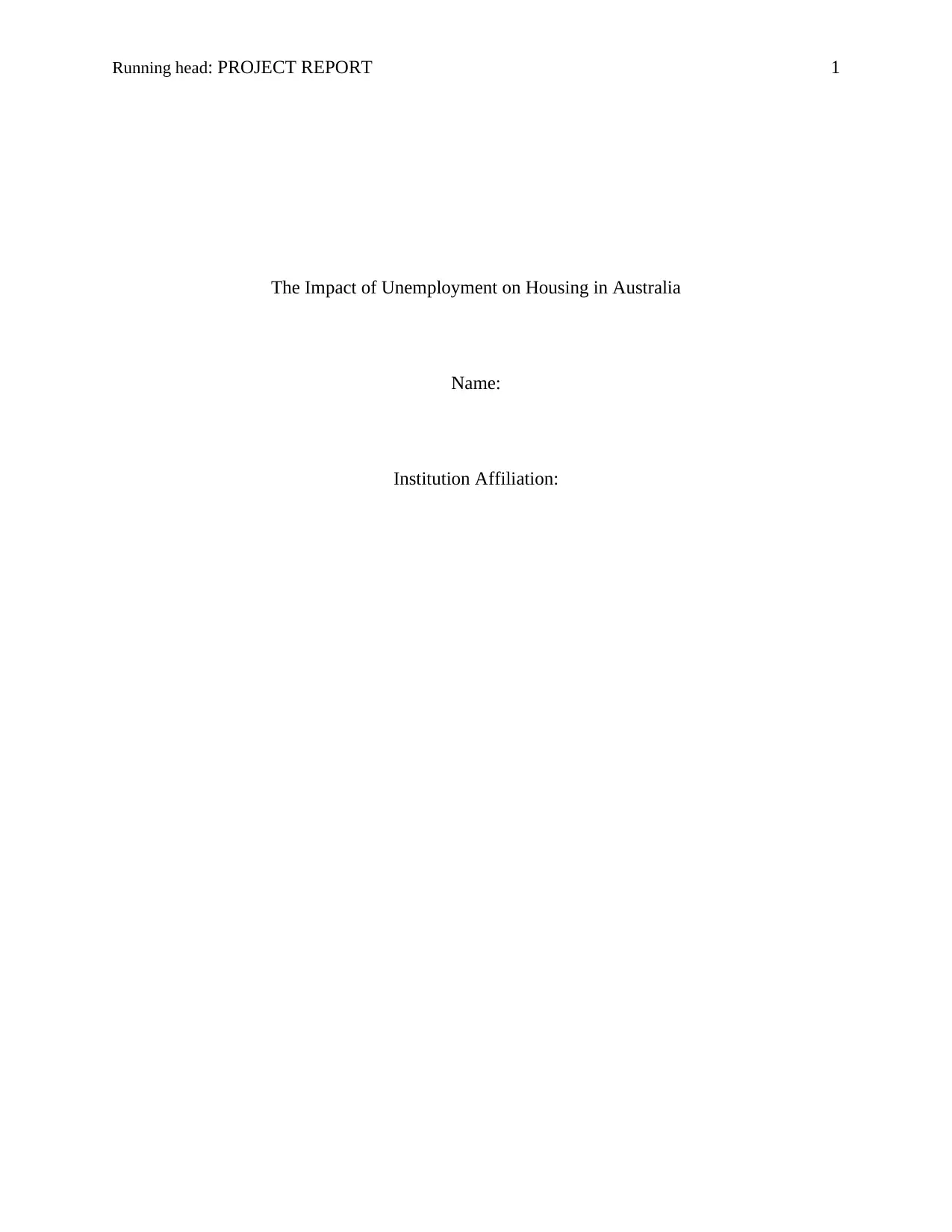
Running head: PROJECT REPORT 1
The Impact of Unemployment on Housing in Australia
Name:
Institution Affiliation:
The Impact of Unemployment on Housing in Australia
Name:
Institution Affiliation:
Secure Best Marks with AI Grader
Need help grading? Try our AI Grader for instant feedback on your assignments.
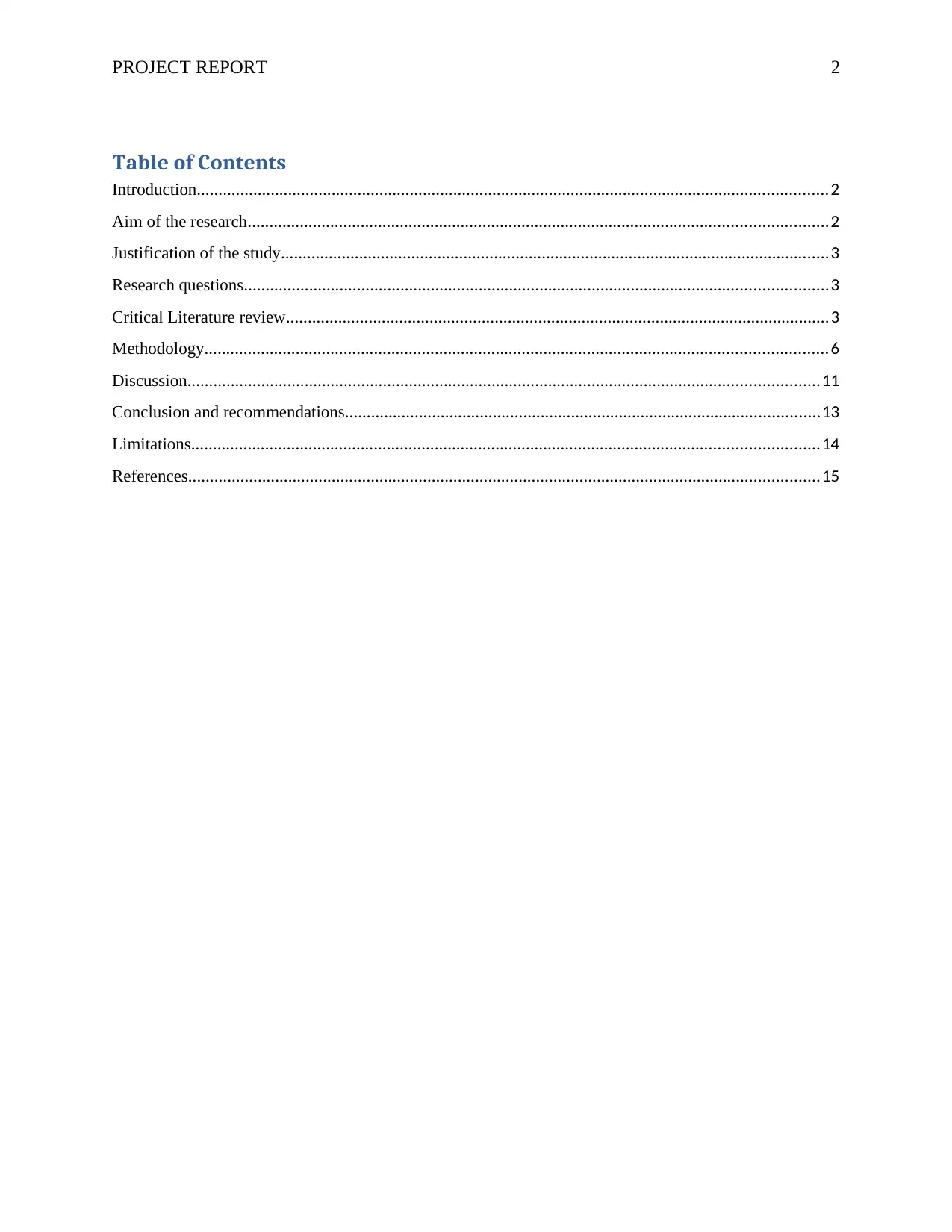
PROJECT REPORT 2
Table of Contents
Introduction.................................................................................................................................................2
Aim of the research.....................................................................................................................................2
Justification of the study..............................................................................................................................3
Research questions......................................................................................................................................3
Critical Literature review.............................................................................................................................3
Methodology...............................................................................................................................................6
Discussion.................................................................................................................................................11
Conclusion and recommendations.............................................................................................................13
Limitations................................................................................................................................................14
References.................................................................................................................................................15
Table of Contents
Introduction.................................................................................................................................................2
Aim of the research.....................................................................................................................................2
Justification of the study..............................................................................................................................3
Research questions......................................................................................................................................3
Critical Literature review.............................................................................................................................3
Methodology...............................................................................................................................................6
Discussion.................................................................................................................................................11
Conclusion and recommendations.............................................................................................................13
Limitations................................................................................................................................................14
References.................................................................................................................................................15
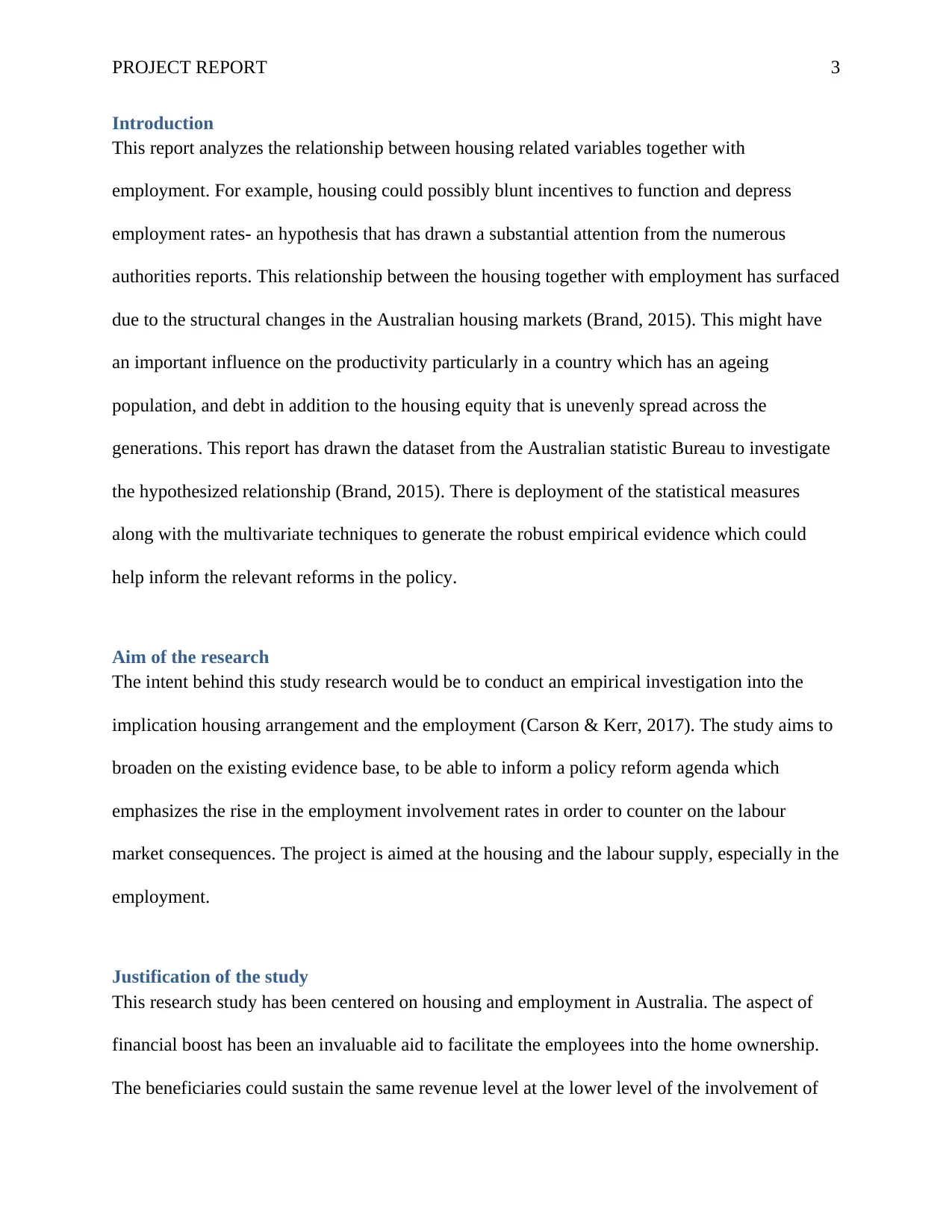
PROJECT REPORT 3
Introduction
This report analyzes the relationship between housing related variables together with
employment. For example, housing could possibly blunt incentives to function and depress
employment rates- an hypothesis that has drawn a substantial attention from the numerous
authorities reports. This relationship between the housing together with employment has surfaced
due to the structural changes in the Australian housing markets (Brand, 2015). This might have
an important influence on the productivity particularly in a country which has an ageing
population, and debt in addition to the housing equity that is unevenly spread across the
generations. This report has drawn the dataset from the Australian statistic Bureau to investigate
the hypothesized relationship (Brand, 2015). There is deployment of the statistical measures
along with the multivariate techniques to generate the robust empirical evidence which could
help inform the relevant reforms in the policy.
Aim of the research
The intent behind this study research would be to conduct an empirical investigation into the
implication housing arrangement and the employment (Carson & Kerr, 2017). The study aims to
broaden on the existing evidence base, to be able to inform a policy reform agenda which
emphasizes the rise in the employment involvement rates in order to counter on the labour
market consequences. The project is aimed at the housing and the labour supply, especially in the
employment.
Justification of the study
This research study has been centered on housing and employment in Australia. The aspect of
financial boost has been an invaluable aid to facilitate the employees into the home ownership.
The beneficiaries could sustain the same revenue level at the lower level of the involvement of
Introduction
This report analyzes the relationship between housing related variables together with
employment. For example, housing could possibly blunt incentives to function and depress
employment rates- an hypothesis that has drawn a substantial attention from the numerous
authorities reports. This relationship between the housing together with employment has surfaced
due to the structural changes in the Australian housing markets (Brand, 2015). This might have
an important influence on the productivity particularly in a country which has an ageing
population, and debt in addition to the housing equity that is unevenly spread across the
generations. This report has drawn the dataset from the Australian statistic Bureau to investigate
the hypothesized relationship (Brand, 2015). There is deployment of the statistical measures
along with the multivariate techniques to generate the robust empirical evidence which could
help inform the relevant reforms in the policy.
Aim of the research
The intent behind this study research would be to conduct an empirical investigation into the
implication housing arrangement and the employment (Carson & Kerr, 2017). The study aims to
broaden on the existing evidence base, to be able to inform a policy reform agenda which
emphasizes the rise in the employment involvement rates in order to counter on the labour
market consequences. The project is aimed at the housing and the labour supply, especially in the
employment.
Justification of the study
This research study has been centered on housing and employment in Australia. The aspect of
financial boost has been an invaluable aid to facilitate the employees into the home ownership.
The beneficiaries could sustain the same revenue level at the lower level of the involvement of
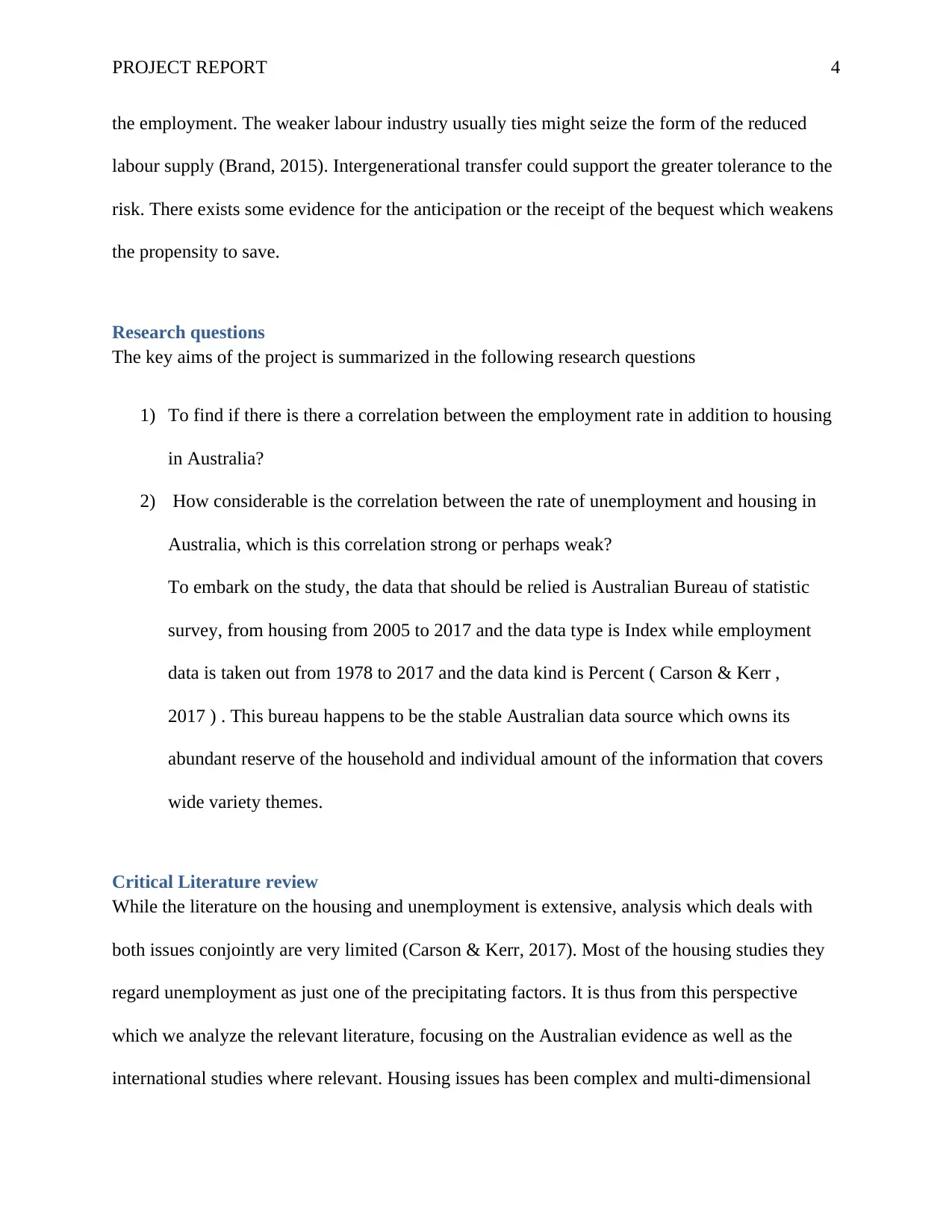
PROJECT REPORT 4
the employment. The weaker labour industry usually ties might seize the form of the reduced
labour supply (Brand, 2015). Intergenerational transfer could support the greater tolerance to the
risk. There exists some evidence for the anticipation or the receipt of the bequest which weakens
the propensity to save.
Research questions
The key aims of the project is summarized in the following research questions
1) To find if there is there a correlation between the employment rate in addition to housing
in Australia?
2) How considerable is the correlation between the rate of unemployment and housing in
Australia, which is this correlation strong or perhaps weak?
To embark on the study, the data that should be relied is Australian Bureau of statistic
survey, from housing from 2005 to 2017 and the data type is Index while employment
data is taken out from 1978 to 2017 and the data kind is Percent ( Carson & Kerr ,
2017 ) . This bureau happens to be the stable Australian data source which owns its
abundant reserve of the household and individual amount of the information that covers
wide variety themes.
Critical Literature review
While the literature on the housing and unemployment is extensive, analysis which deals with
both issues conjointly are very limited (Carson & Kerr, 2017). Most of the housing studies they
regard unemployment as just one of the precipitating factors. It is thus from this perspective
which we analyze the relevant literature, focusing on the Australian evidence as well as the
international studies where relevant. Housing issues has been complex and multi-dimensional
the employment. The weaker labour industry usually ties might seize the form of the reduced
labour supply (Brand, 2015). Intergenerational transfer could support the greater tolerance to the
risk. There exists some evidence for the anticipation or the receipt of the bequest which weakens
the propensity to save.
Research questions
The key aims of the project is summarized in the following research questions
1) To find if there is there a correlation between the employment rate in addition to housing
in Australia?
2) How considerable is the correlation between the rate of unemployment and housing in
Australia, which is this correlation strong or perhaps weak?
To embark on the study, the data that should be relied is Australian Bureau of statistic
survey, from housing from 2005 to 2017 and the data type is Index while employment
data is taken out from 1978 to 2017 and the data kind is Percent ( Carson & Kerr ,
2017 ) . This bureau happens to be the stable Australian data source which owns its
abundant reserve of the household and individual amount of the information that covers
wide variety themes.
Critical Literature review
While the literature on the housing and unemployment is extensive, analysis which deals with
both issues conjointly are very limited (Carson & Kerr, 2017). Most of the housing studies they
regard unemployment as just one of the precipitating factors. It is thus from this perspective
which we analyze the relevant literature, focusing on the Australian evidence as well as the
international studies where relevant. Housing issues has been complex and multi-dimensional
Secure Best Marks with AI Grader
Need help grading? Try our AI Grader for instant feedback on your assignments.
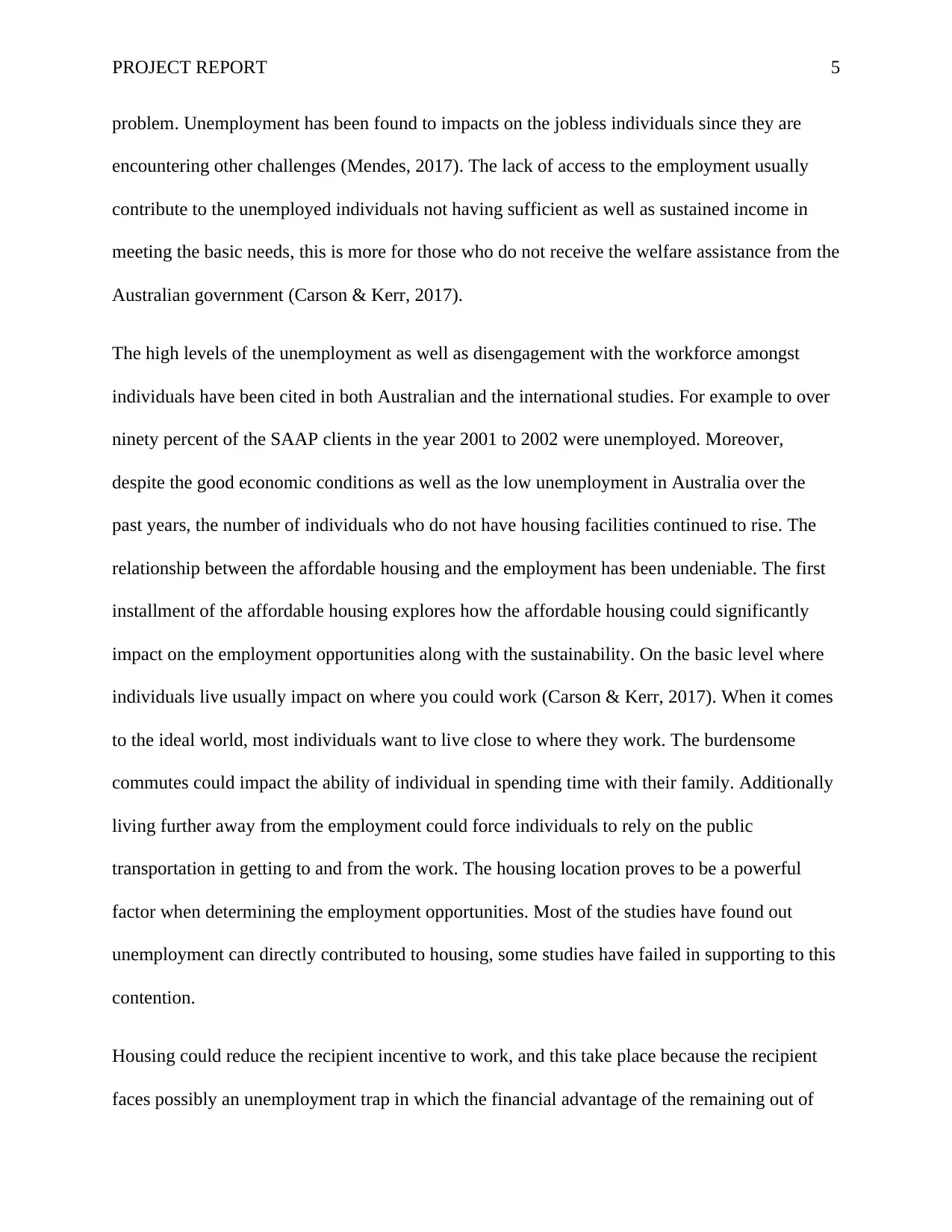
PROJECT REPORT 5
problem. Unemployment has been found to impacts on the jobless individuals since they are
encountering other challenges (Mendes, 2017). The lack of access to the employment usually
contribute to the unemployed individuals not having sufficient as well as sustained income in
meeting the basic needs, this is more for those who do not receive the welfare assistance from the
Australian government (Carson & Kerr, 2017).
The high levels of the unemployment as well as disengagement with the workforce amongst
individuals have been cited in both Australian and the international studies. For example to over
ninety percent of the SAAP clients in the year 2001 to 2002 were unemployed. Moreover,
despite the good economic conditions as well as the low unemployment in Australia over the
past years, the number of individuals who do not have housing facilities continued to rise. The
relationship between the affordable housing and the employment has been undeniable. The first
installment of the affordable housing explores how the affordable housing could significantly
impact on the employment opportunities along with the sustainability. On the basic level where
individuals live usually impact on where you could work (Carson & Kerr, 2017). When it comes
to the ideal world, most individuals want to live close to where they work. The burdensome
commutes could impact the ability of individual in spending time with their family. Additionally
living further away from the employment could force individuals to rely on the public
transportation in getting to and from the work. The housing location proves to be a powerful
factor when determining the employment opportunities. Most of the studies have found out
unemployment can directly contributed to housing, some studies have failed in supporting to this
contention.
Housing could reduce the recipient incentive to work, and this take place because the recipient
faces possibly an unemployment trap in which the financial advantage of the remaining out of
problem. Unemployment has been found to impacts on the jobless individuals since they are
encountering other challenges (Mendes, 2017). The lack of access to the employment usually
contribute to the unemployed individuals not having sufficient as well as sustained income in
meeting the basic needs, this is more for those who do not receive the welfare assistance from the
Australian government (Carson & Kerr, 2017).
The high levels of the unemployment as well as disengagement with the workforce amongst
individuals have been cited in both Australian and the international studies. For example to over
ninety percent of the SAAP clients in the year 2001 to 2002 were unemployed. Moreover,
despite the good economic conditions as well as the low unemployment in Australia over the
past years, the number of individuals who do not have housing facilities continued to rise. The
relationship between the affordable housing and the employment has been undeniable. The first
installment of the affordable housing explores how the affordable housing could significantly
impact on the employment opportunities along with the sustainability. On the basic level where
individuals live usually impact on where you could work (Carson & Kerr, 2017). When it comes
to the ideal world, most individuals want to live close to where they work. The burdensome
commutes could impact the ability of individual in spending time with their family. Additionally
living further away from the employment could force individuals to rely on the public
transportation in getting to and from the work. The housing location proves to be a powerful
factor when determining the employment opportunities. Most of the studies have found out
unemployment can directly contributed to housing, some studies have failed in supporting to this
contention.
Housing could reduce the recipient incentive to work, and this take place because the recipient
faces possibly an unemployment trap in which the financial advantage of the remaining out of
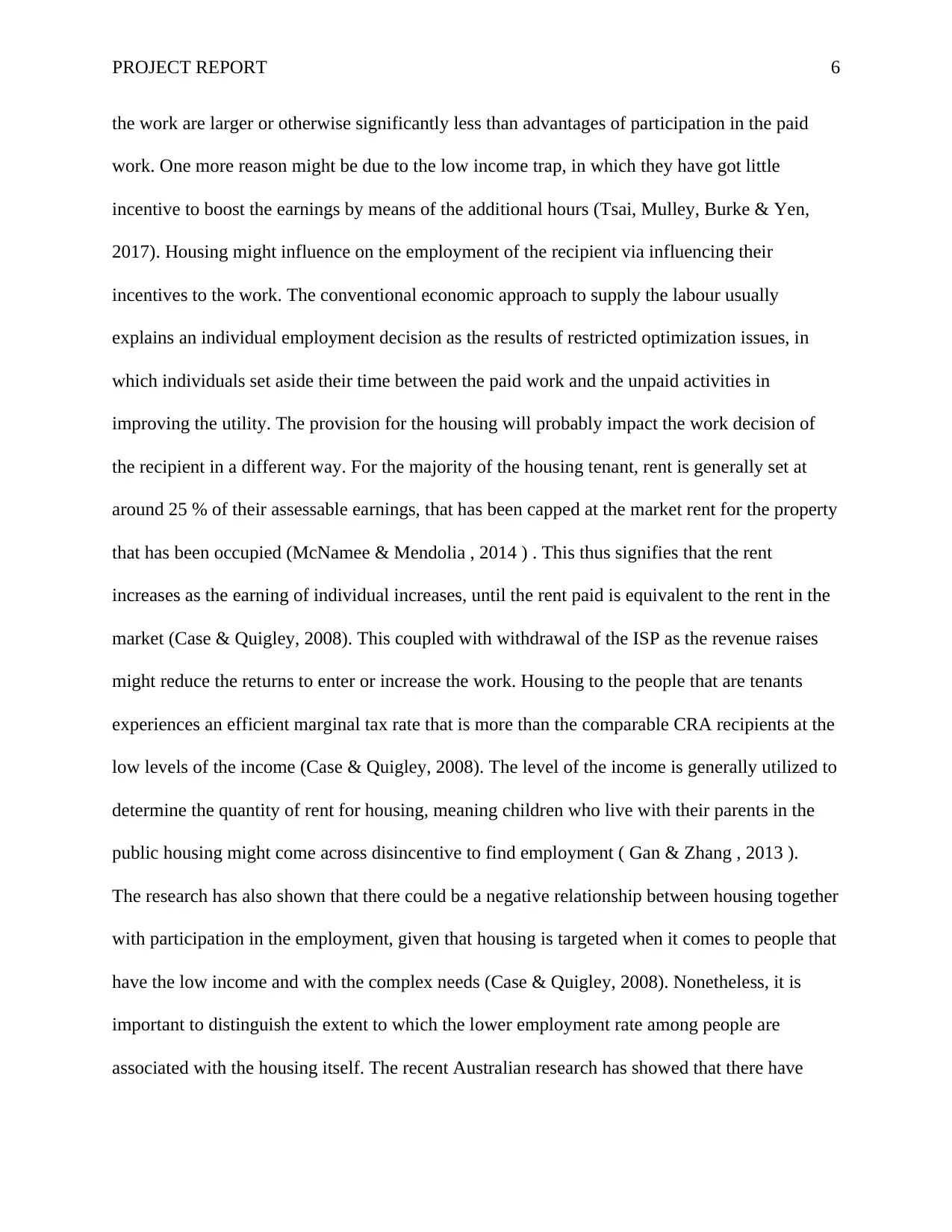
PROJECT REPORT 6
the work are larger or otherwise significantly less than advantages of participation in the paid
work. One more reason might be due to the low income trap, in which they have got little
incentive to boost the earnings by means of the additional hours (Tsai, Mulley, Burke & Yen,
2017). Housing might influence on the employment of the recipient via influencing their
incentives to the work. The conventional economic approach to supply the labour usually
explains an individual employment decision as the results of restricted optimization issues, in
which individuals set aside their time between the paid work and the unpaid activities in
improving the utility. The provision for the housing will probably impact the work decision of
the recipient in a different way. For the majority of the housing tenant, rent is generally set at
around 25 % of their assessable earnings, that has been capped at the market rent for the property
that has been occupied (McNamee & Mendolia , 2014 ) . This thus signifies that the rent
increases as the earning of individual increases, until the rent paid is equivalent to the rent in the
market (Case & Quigley, 2008). This coupled with withdrawal of the ISP as the revenue raises
might reduce the returns to enter or increase the work. Housing to the people that are tenants
experiences an efficient marginal tax rate that is more than the comparable CRA recipients at the
low levels of the income (Case & Quigley, 2008). The level of the income is generally utilized to
determine the quantity of rent for housing, meaning children who live with their parents in the
public housing might come across disincentive to find employment ( Gan & Zhang , 2013 ).
The research has also shown that there could be a negative relationship between housing together
with participation in the employment, given that housing is targeted when it comes to people that
have the low income and with the complex needs (Case & Quigley, 2008). Nonetheless, it is
important to distinguish the extent to which the lower employment rate among people are
associated with the housing itself. The recent Australian research has showed that there have
the work are larger or otherwise significantly less than advantages of participation in the paid
work. One more reason might be due to the low income trap, in which they have got little
incentive to boost the earnings by means of the additional hours (Tsai, Mulley, Burke & Yen,
2017). Housing might influence on the employment of the recipient via influencing their
incentives to the work. The conventional economic approach to supply the labour usually
explains an individual employment decision as the results of restricted optimization issues, in
which individuals set aside their time between the paid work and the unpaid activities in
improving the utility. The provision for the housing will probably impact the work decision of
the recipient in a different way. For the majority of the housing tenant, rent is generally set at
around 25 % of their assessable earnings, that has been capped at the market rent for the property
that has been occupied (McNamee & Mendolia , 2014 ) . This thus signifies that the rent
increases as the earning of individual increases, until the rent paid is equivalent to the rent in the
market (Case & Quigley, 2008). This coupled with withdrawal of the ISP as the revenue raises
might reduce the returns to enter or increase the work. Housing to the people that are tenants
experiences an efficient marginal tax rate that is more than the comparable CRA recipients at the
low levels of the income (Case & Quigley, 2008). The level of the income is generally utilized to
determine the quantity of rent for housing, meaning children who live with their parents in the
public housing might come across disincentive to find employment ( Gan & Zhang , 2013 ).
The research has also shown that there could be a negative relationship between housing together
with participation in the employment, given that housing is targeted when it comes to people that
have the low income and with the complex needs (Case & Quigley, 2008). Nonetheless, it is
important to distinguish the extent to which the lower employment rate among people are
associated with the housing itself. The recent Australian research has showed that there have
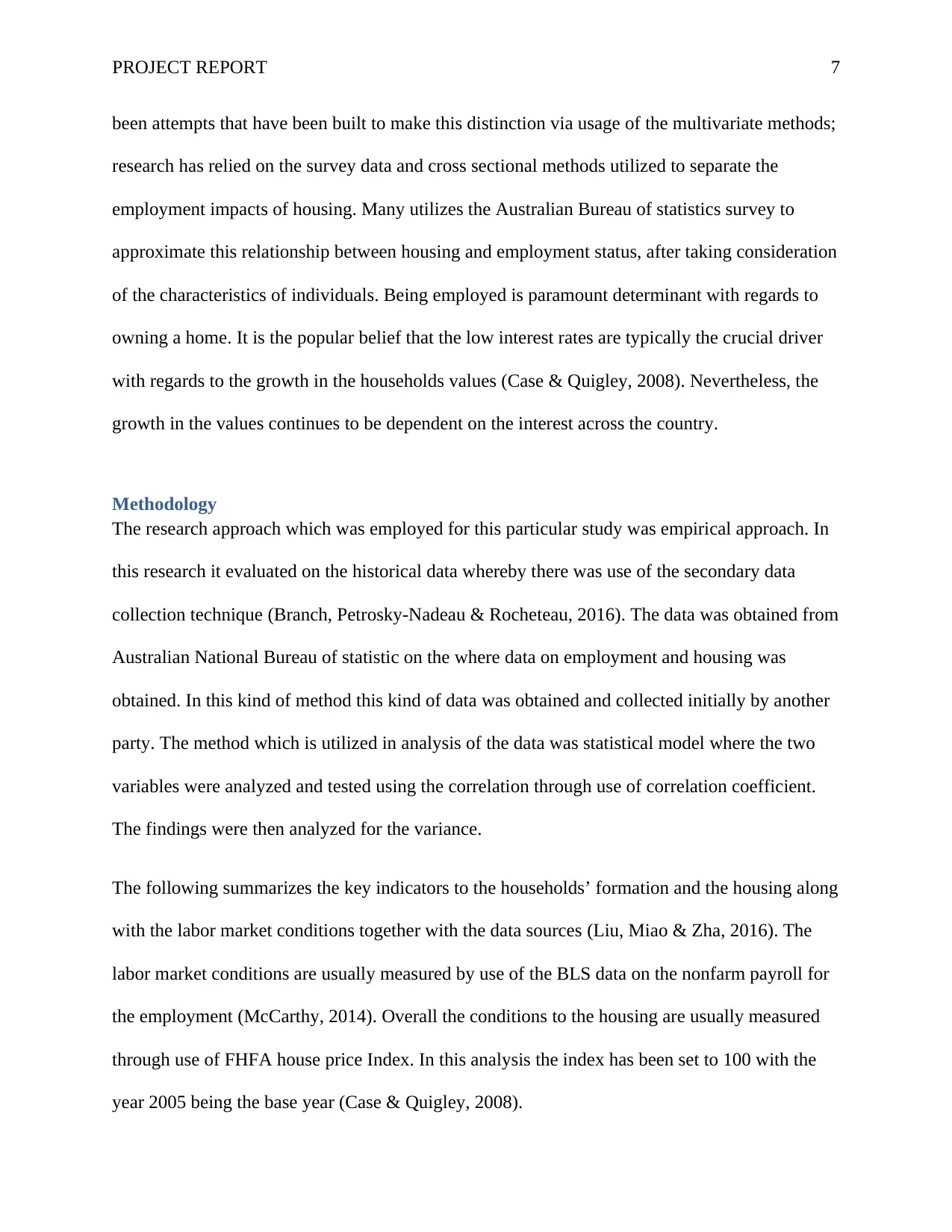
PROJECT REPORT 7
been attempts that have been built to make this distinction via usage of the multivariate methods;
research has relied on the survey data and cross sectional methods utilized to separate the
employment impacts of housing. Many utilizes the Australian Bureau of statistics survey to
approximate this relationship between housing and employment status, after taking consideration
of the characteristics of individuals. Being employed is paramount determinant with regards to
owning a home. It is the popular belief that the low interest rates are typically the crucial driver
with regards to the growth in the households values (Case & Quigley, 2008). Nevertheless, the
growth in the values continues to be dependent on the interest across the country.
Methodology
The research approach which was employed for this particular study was empirical approach. In
this research it evaluated on the historical data whereby there was use of the secondary data
collection technique (Branch, Petrosky-Nadeau & Rocheteau, 2016). The data was obtained from
Australian National Bureau of statistic on the where data on employment and housing was
obtained. In this kind of method this kind of data was obtained and collected initially by another
party. The method which is utilized in analysis of the data was statistical model where the two
variables were analyzed and tested using the correlation through use of correlation coefficient.
The findings were then analyzed for the variance.
The following summarizes the key indicators to the households’ formation and the housing along
with the labor market conditions together with the data sources (Liu, Miao & Zha, 2016). The
labor market conditions are usually measured by use of the BLS data on the nonfarm payroll for
the employment (McCarthy, 2014). Overall the conditions to the housing are usually measured
through use of FHFA house price Index. In this analysis the index has been set to 100 with the
year 2005 being the base year (Case & Quigley, 2008).
been attempts that have been built to make this distinction via usage of the multivariate methods;
research has relied on the survey data and cross sectional methods utilized to separate the
employment impacts of housing. Many utilizes the Australian Bureau of statistics survey to
approximate this relationship between housing and employment status, after taking consideration
of the characteristics of individuals. Being employed is paramount determinant with regards to
owning a home. It is the popular belief that the low interest rates are typically the crucial driver
with regards to the growth in the households values (Case & Quigley, 2008). Nevertheless, the
growth in the values continues to be dependent on the interest across the country.
Methodology
The research approach which was employed for this particular study was empirical approach. In
this research it evaluated on the historical data whereby there was use of the secondary data
collection technique (Branch, Petrosky-Nadeau & Rocheteau, 2016). The data was obtained from
Australian National Bureau of statistic on the where data on employment and housing was
obtained. In this kind of method this kind of data was obtained and collected initially by another
party. The method which is utilized in analysis of the data was statistical model where the two
variables were analyzed and tested using the correlation through use of correlation coefficient.
The findings were then analyzed for the variance.
The following summarizes the key indicators to the households’ formation and the housing along
with the labor market conditions together with the data sources (Liu, Miao & Zha, 2016). The
labor market conditions are usually measured by use of the BLS data on the nonfarm payroll for
the employment (McCarthy, 2014). Overall the conditions to the housing are usually measured
through use of FHFA house price Index. In this analysis the index has been set to 100 with the
year 2005 being the base year (Case & Quigley, 2008).
Paraphrase This Document
Need a fresh take? Get an instant paraphrase of this document with our AI Paraphraser
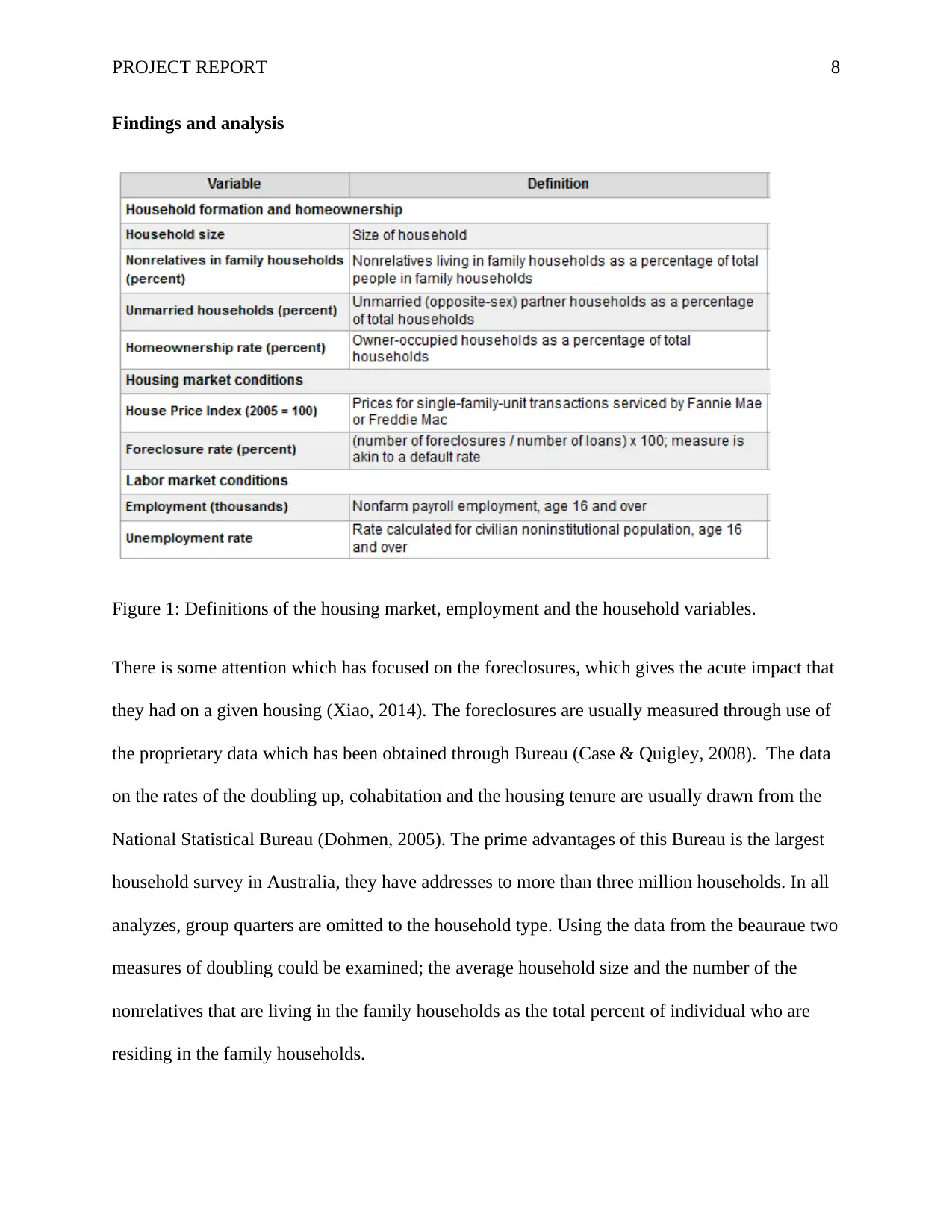
PROJECT REPORT 8
Findings and analysis
Figure 1: Definitions of the housing market, employment and the household variables.
There is some attention which has focused on the foreclosures, which gives the acute impact that
they had on a given housing (Xiao, 2014). The foreclosures are usually measured through use of
the proprietary data which has been obtained through Bureau (Case & Quigley, 2008). The data
on the rates of the doubling up, cohabitation and the housing tenure are usually drawn from the
National Statistical Bureau (Dohmen, 2005). The prime advantages of this Bureau is the largest
household survey in Australia, they have addresses to more than three million households. In all
analyzes, group quarters are omitted to the household type. Using the data from the beauraue two
measures of doubling could be examined; the average household size and the number of the
nonrelatives that are living in the family households as the total percent of individual who are
residing in the family households.
Findings and analysis
Figure 1: Definitions of the housing market, employment and the household variables.
There is some attention which has focused on the foreclosures, which gives the acute impact that
they had on a given housing (Xiao, 2014). The foreclosures are usually measured through use of
the proprietary data which has been obtained through Bureau (Case & Quigley, 2008). The data
on the rates of the doubling up, cohabitation and the housing tenure are usually drawn from the
National Statistical Bureau (Dohmen, 2005). The prime advantages of this Bureau is the largest
household survey in Australia, they have addresses to more than three million households. In all
analyzes, group quarters are omitted to the household type. Using the data from the beauraue two
measures of doubling could be examined; the average household size and the number of the
nonrelatives that are living in the family households as the total percent of individual who are
residing in the family households.
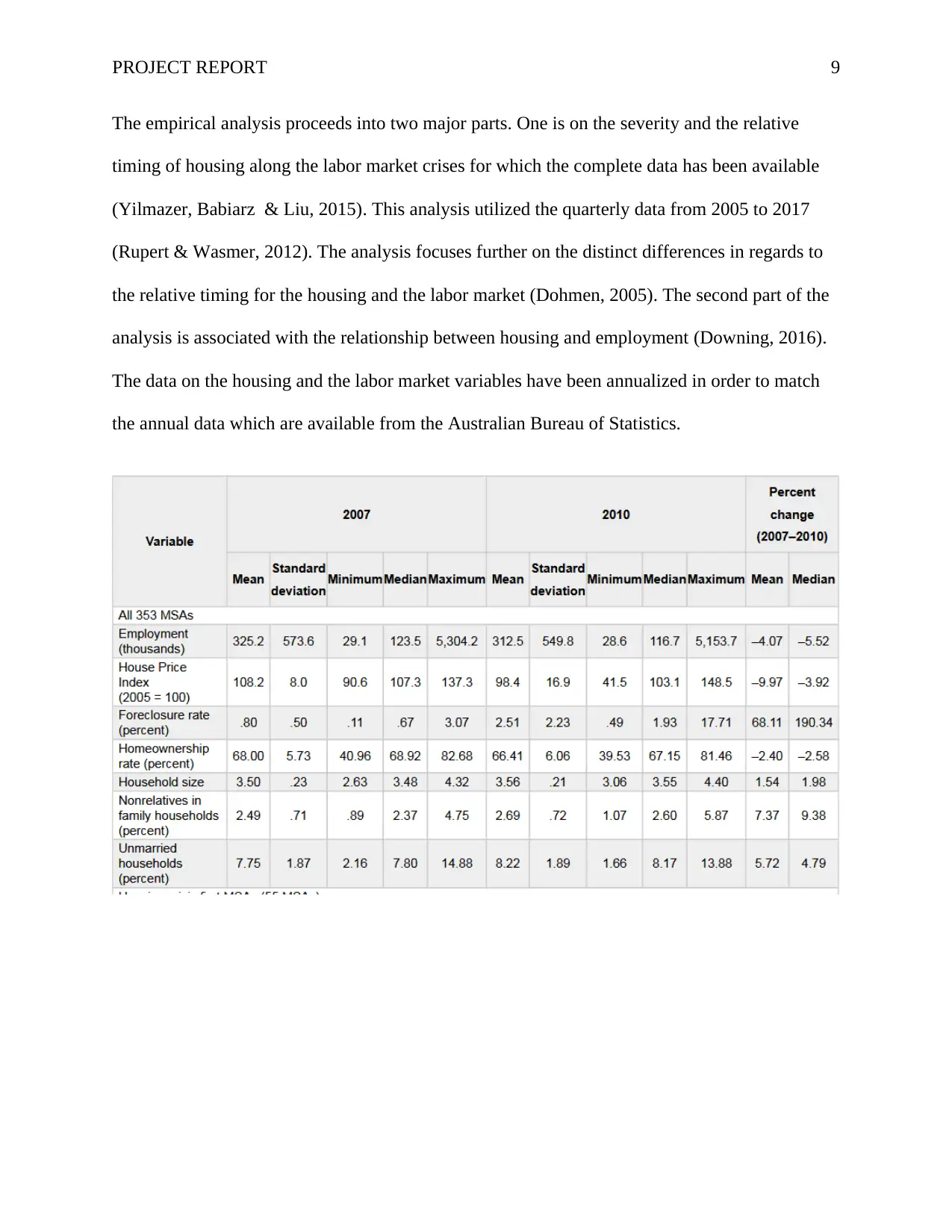
PROJECT REPORT 9
The empirical analysis proceeds into two major parts. One is on the severity and the relative
timing of housing along the labor market crises for which the complete data has been available
(Yilmazer, Babiarz & Liu, 2015). This analysis utilized the quarterly data from 2005 to 2017
(Rupert & Wasmer, 2012). The analysis focuses further on the distinct differences in regards to
the relative timing for the housing and the labor market (Dohmen, 2005). The second part of the
analysis is associated with the relationship between housing and employment (Downing, 2016).
The data on the housing and the labor market variables have been annualized in order to match
the annual data which are available from the Australian Bureau of Statistics.
The empirical analysis proceeds into two major parts. One is on the severity and the relative
timing of housing along the labor market crises for which the complete data has been available
(Yilmazer, Babiarz & Liu, 2015). This analysis utilized the quarterly data from 2005 to 2017
(Rupert & Wasmer, 2012). The analysis focuses further on the distinct differences in regards to
the relative timing for the housing and the labor market (Dohmen, 2005). The second part of the
analysis is associated with the relationship between housing and employment (Downing, 2016).
The data on the housing and the labor market variables have been annualized in order to match
the annual data which are available from the Australian Bureau of Statistics.
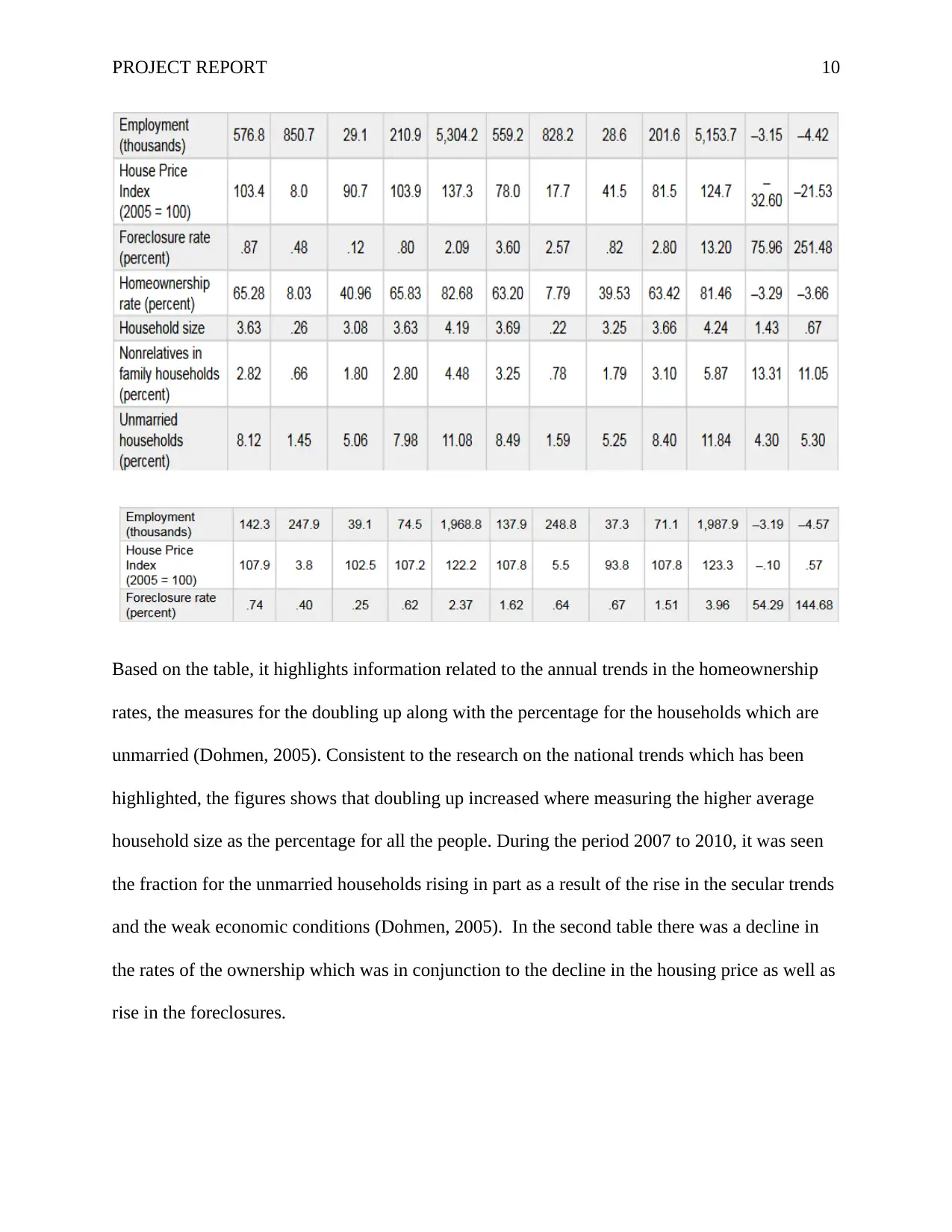
PROJECT REPORT 10
Based on the table, it highlights information related to the annual trends in the homeownership
rates, the measures for the doubling up along with the percentage for the households which are
unmarried (Dohmen, 2005). Consistent to the research on the national trends which has been
highlighted, the figures shows that doubling up increased where measuring the higher average
household size as the percentage for all the people. During the period 2007 to 2010, it was seen
the fraction for the unmarried households rising in part as a result of the rise in the secular trends
and the weak economic conditions (Dohmen, 2005). In the second table there was a decline in
the rates of the ownership which was in conjunction to the decline in the housing price as well as
rise in the foreclosures.
Based on the table, it highlights information related to the annual trends in the homeownership
rates, the measures for the doubling up along with the percentage for the households which are
unmarried (Dohmen, 2005). Consistent to the research on the national trends which has been
highlighted, the figures shows that doubling up increased where measuring the higher average
household size as the percentage for all the people. During the period 2007 to 2010, it was seen
the fraction for the unmarried households rising in part as a result of the rise in the secular trends
and the weak economic conditions (Dohmen, 2005). In the second table there was a decline in
the rates of the ownership which was in conjunction to the decline in the housing price as well as
rise in the foreclosures.
Secure Best Marks with AI Grader
Need help grading? Try our AI Grader for instant feedback on your assignments.
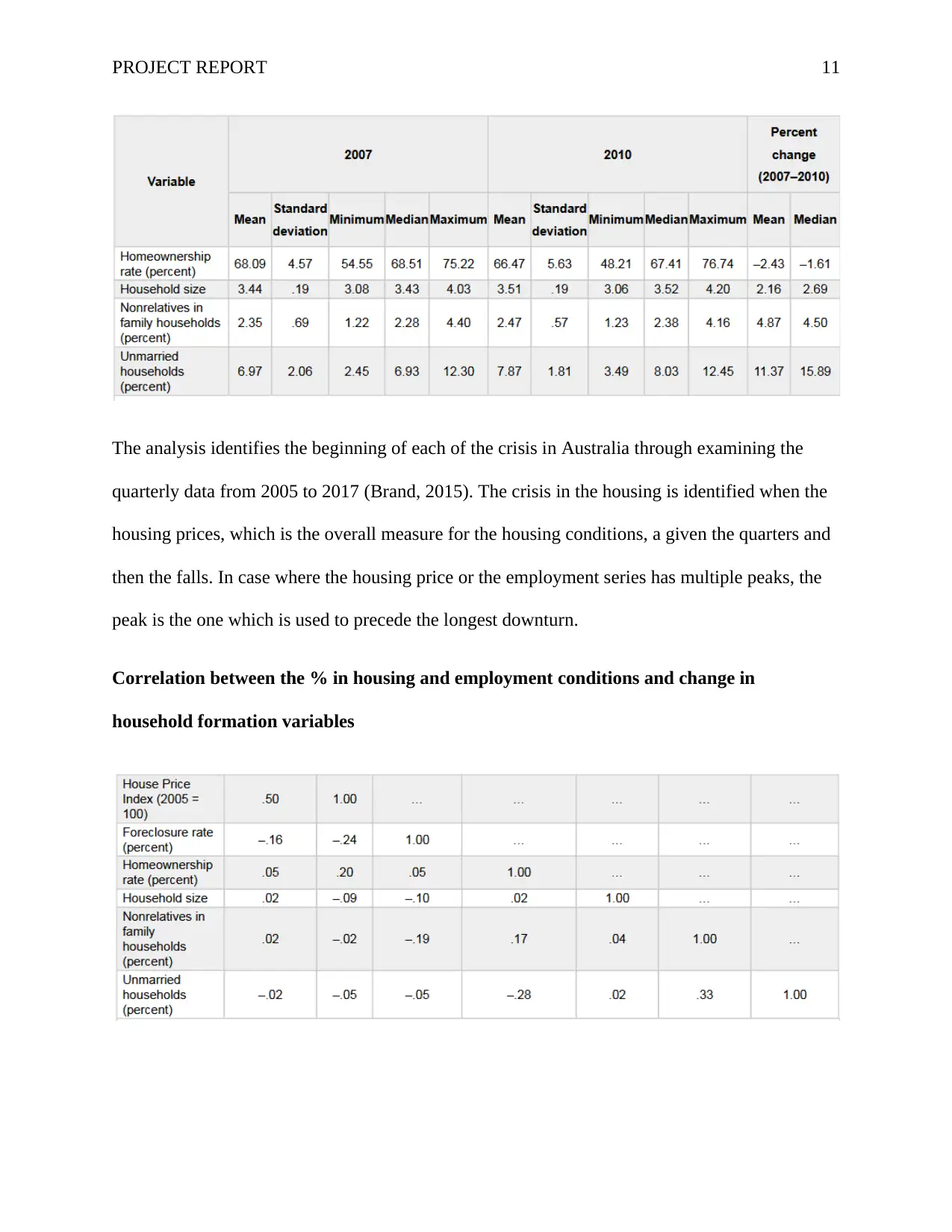
PROJECT REPORT 11
The analysis identifies the beginning of each of the crisis in Australia through examining the
quarterly data from 2005 to 2017 (Brand, 2015). The crisis in the housing is identified when the
housing prices, which is the overall measure for the housing conditions, a given the quarters and
then the falls. In case where the housing price or the employment series has multiple peaks, the
peak is the one which is used to precede the longest downturn.
Correlation between the % in housing and employment conditions and change in
household formation variables
The analysis identifies the beginning of each of the crisis in Australia through examining the
quarterly data from 2005 to 2017 (Brand, 2015). The crisis in the housing is identified when the
housing prices, which is the overall measure for the housing conditions, a given the quarters and
then the falls. In case where the housing price or the employment series has multiple peaks, the
peak is the one which is used to precede the longest downturn.
Correlation between the % in housing and employment conditions and change in
household formation variables
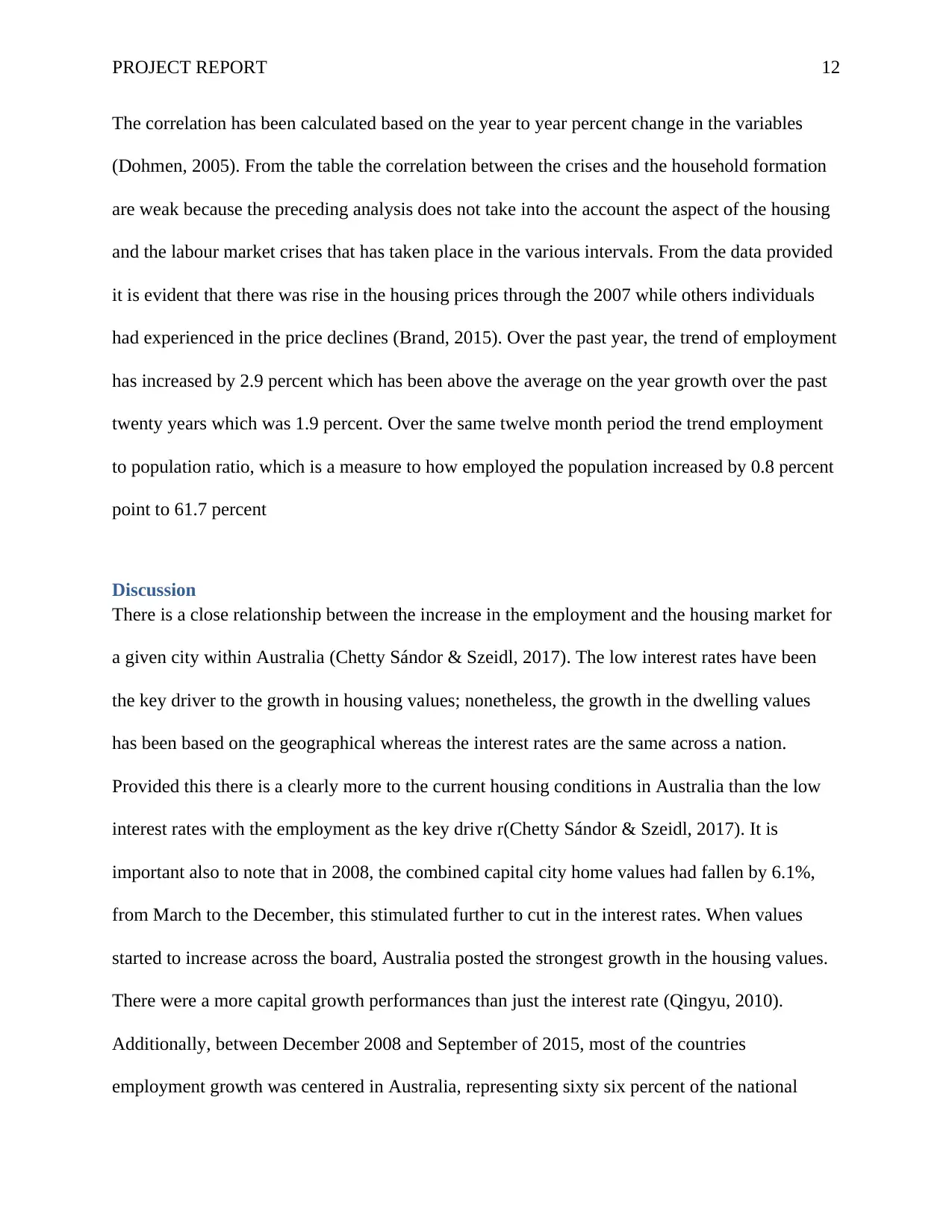
PROJECT REPORT 12
The correlation has been calculated based on the year to year percent change in the variables
(Dohmen, 2005). From the table the correlation between the crises and the household formation
are weak because the preceding analysis does not take into the account the aspect of the housing
and the labour market crises that has taken place in the various intervals. From the data provided
it is evident that there was rise in the housing prices through the 2007 while others individuals
had experienced in the price declines (Brand, 2015). Over the past year, the trend of employment
has increased by 2.9 percent which has been above the average on the year growth over the past
twenty years which was 1.9 percent. Over the same twelve month period the trend employment
to population ratio, which is a measure to how employed the population increased by 0.8 percent
point to 61.7 percent
Discussion
There is a close relationship between the increase in the employment and the housing market for
a given city within Australia (Chetty Sándor & Szeidl, 2017). The low interest rates have been
the key driver to the growth in housing values; nonetheless, the growth in the dwelling values
has been based on the geographical whereas the interest rates are the same across a nation.
Provided this there is a clearly more to the current housing conditions in Australia than the low
interest rates with the employment as the key drive r(Chetty Sándor & Szeidl, 2017). It is
important also to note that in 2008, the combined capital city home values had fallen by 6.1%,
from March to the December, this stimulated further to cut in the interest rates. When values
started to increase across the board, Australia posted the strongest growth in the housing values.
There were a more capital growth performances than just the interest rate (Qingyu, 2010).
Additionally, between December 2008 and September of 2015, most of the countries
employment growth was centered in Australia, representing sixty six percent of the national
The correlation has been calculated based on the year to year percent change in the variables
(Dohmen, 2005). From the table the correlation between the crises and the household formation
are weak because the preceding analysis does not take into the account the aspect of the housing
and the labour market crises that has taken place in the various intervals. From the data provided
it is evident that there was rise in the housing prices through the 2007 while others individuals
had experienced in the price declines (Brand, 2015). Over the past year, the trend of employment
has increased by 2.9 percent which has been above the average on the year growth over the past
twenty years which was 1.9 percent. Over the same twelve month period the trend employment
to population ratio, which is a measure to how employed the population increased by 0.8 percent
point to 61.7 percent
Discussion
There is a close relationship between the increase in the employment and the housing market for
a given city within Australia (Chetty Sándor & Szeidl, 2017). The low interest rates have been
the key driver to the growth in housing values; nonetheless, the growth in the dwelling values
has been based on the geographical whereas the interest rates are the same across a nation.
Provided this there is a clearly more to the current housing conditions in Australia than the low
interest rates with the employment as the key drive r(Chetty Sándor & Szeidl, 2017). It is
important also to note that in 2008, the combined capital city home values had fallen by 6.1%,
from March to the December, this stimulated further to cut in the interest rates. When values
started to increase across the board, Australia posted the strongest growth in the housing values.
There were a more capital growth performances than just the interest rate (Qingyu, 2010).
Additionally, between December 2008 and September of 2015, most of the countries
employment growth was centered in Australia, representing sixty six percent of the national
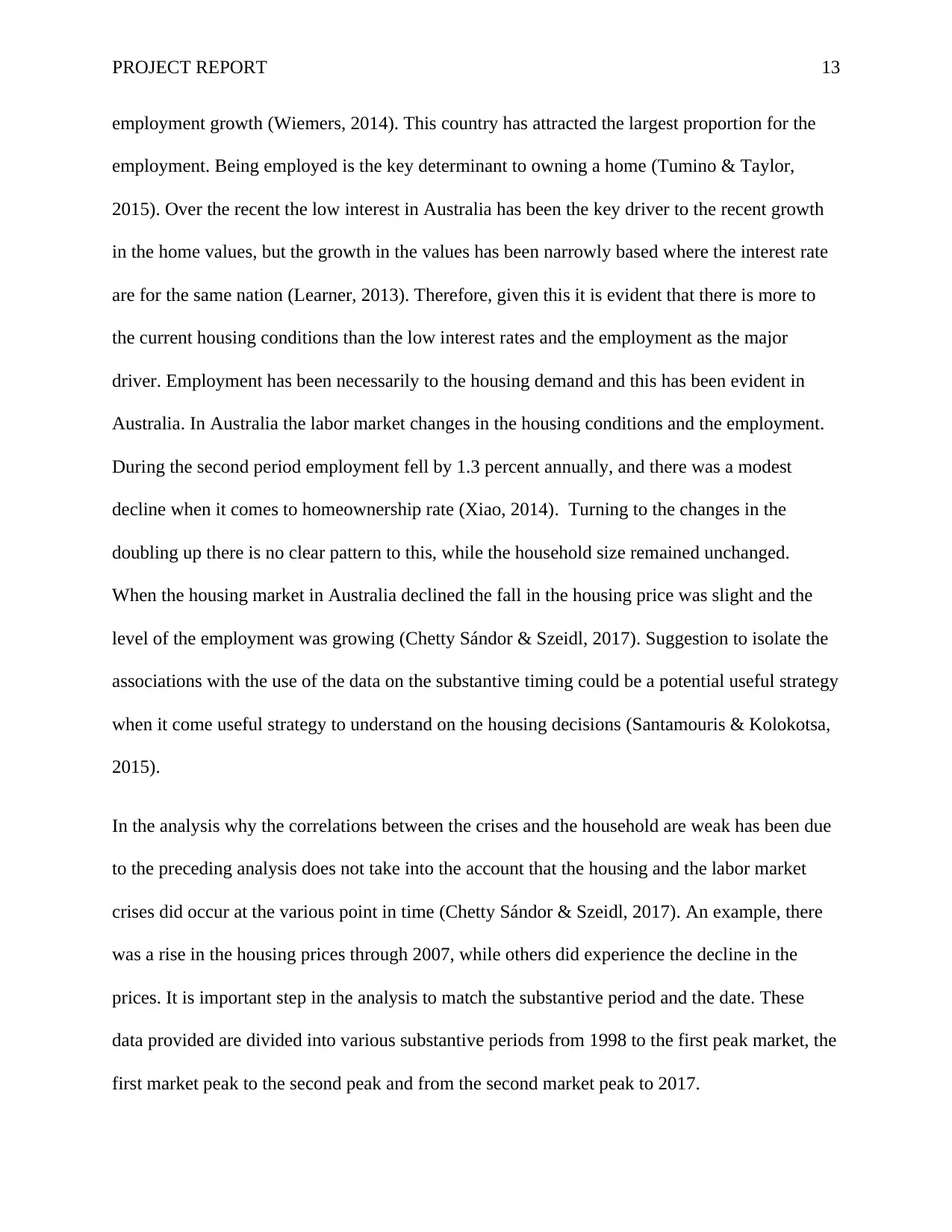
PROJECT REPORT 13
employment growth (Wiemers, 2014). This country has attracted the largest proportion for the
employment. Being employed is the key determinant to owning a home (Tumino & Taylor,
2015). Over the recent the low interest in Australia has been the key driver to the recent growth
in the home values, but the growth in the values has been narrowly based where the interest rate
are for the same nation (Learner, 2013). Therefore, given this it is evident that there is more to
the current housing conditions than the low interest rates and the employment as the major
driver. Employment has been necessarily to the housing demand and this has been evident in
Australia. In Australia the labor market changes in the housing conditions and the employment.
During the second period employment fell by 1.3 percent annually, and there was a modest
decline when it comes to homeownership rate (Xiao, 2014). Turning to the changes in the
doubling up there is no clear pattern to this, while the household size remained unchanged.
When the housing market in Australia declined the fall in the housing price was slight and the
level of the employment was growing (Chetty Sándor & Szeidl, 2017). Suggestion to isolate the
associations with the use of the data on the substantive timing could be a potential useful strategy
when it come useful strategy to understand on the housing decisions (Santamouris & Kolokotsa,
2015).
In the analysis why the correlations between the crises and the household are weak has been due
to the preceding analysis does not take into the account that the housing and the labor market
crises did occur at the various point in time (Chetty Sándor & Szeidl, 2017). An example, there
was a rise in the housing prices through 2007, while others did experience the decline in the
prices. It is important step in the analysis to match the substantive period and the date. These
data provided are divided into various substantive periods from 1998 to the first peak market, the
first market peak to the second peak and from the second market peak to 2017.
employment growth (Wiemers, 2014). This country has attracted the largest proportion for the
employment. Being employed is the key determinant to owning a home (Tumino & Taylor,
2015). Over the recent the low interest in Australia has been the key driver to the recent growth
in the home values, but the growth in the values has been narrowly based where the interest rate
are for the same nation (Learner, 2013). Therefore, given this it is evident that there is more to
the current housing conditions than the low interest rates and the employment as the major
driver. Employment has been necessarily to the housing demand and this has been evident in
Australia. In Australia the labor market changes in the housing conditions and the employment.
During the second period employment fell by 1.3 percent annually, and there was a modest
decline when it comes to homeownership rate (Xiao, 2014). Turning to the changes in the
doubling up there is no clear pattern to this, while the household size remained unchanged.
When the housing market in Australia declined the fall in the housing price was slight and the
level of the employment was growing (Chetty Sándor & Szeidl, 2017). Suggestion to isolate the
associations with the use of the data on the substantive timing could be a potential useful strategy
when it come useful strategy to understand on the housing decisions (Santamouris & Kolokotsa,
2015).
In the analysis why the correlations between the crises and the household are weak has been due
to the preceding analysis does not take into the account that the housing and the labor market
crises did occur at the various point in time (Chetty Sándor & Szeidl, 2017). An example, there
was a rise in the housing prices through 2007, while others did experience the decline in the
prices. It is important step in the analysis to match the substantive period and the date. These
data provided are divided into various substantive periods from 1998 to the first peak market, the
first market peak to the second peak and from the second market peak to 2017.
Paraphrase This Document
Need a fresh take? Get an instant paraphrase of this document with our AI Paraphraser
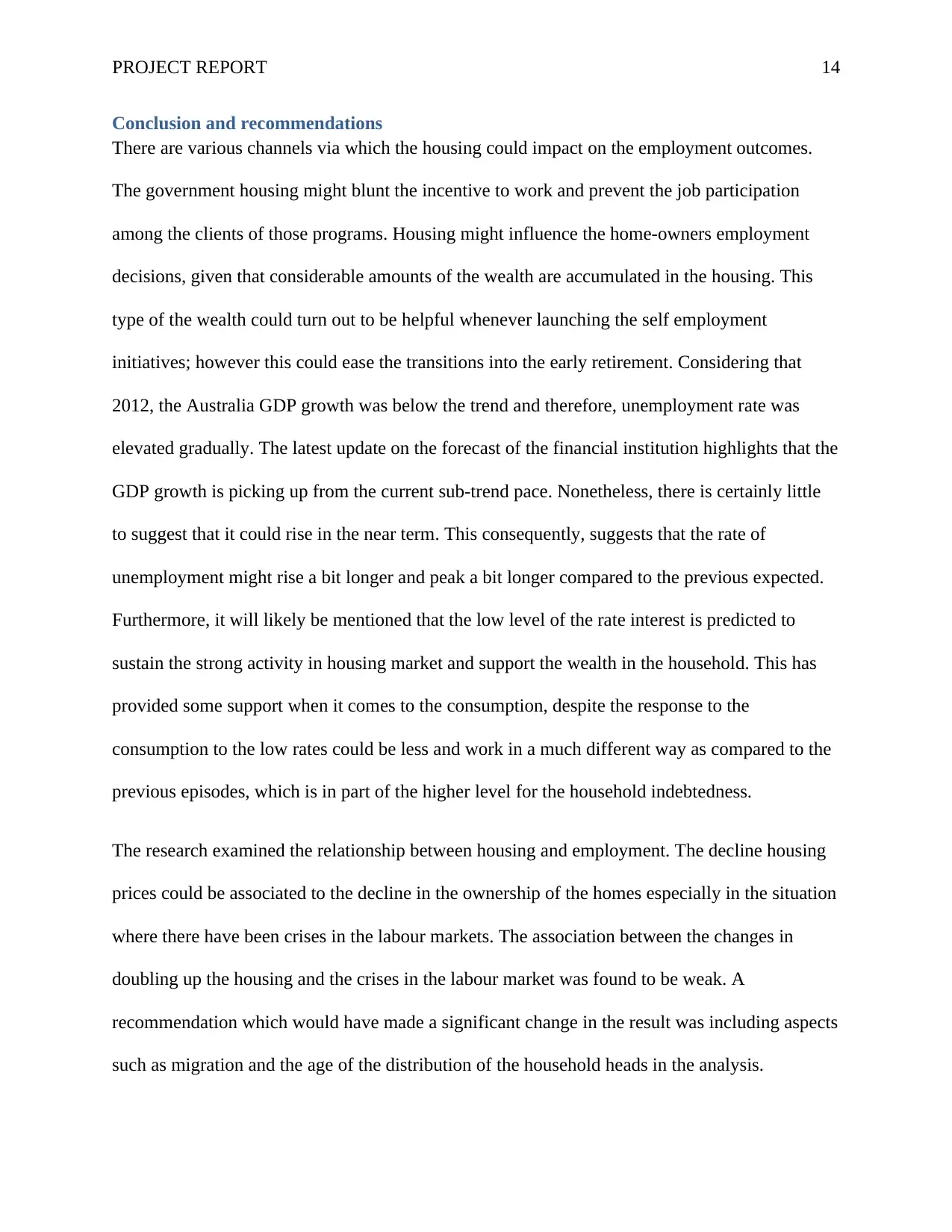
PROJECT REPORT 14
Conclusion and recommendations
There are various channels via which the housing could impact on the employment outcomes.
The government housing might blunt the incentive to work and prevent the job participation
among the clients of those programs. Housing might influence the home-owners employment
decisions, given that considerable amounts of the wealth are accumulated in the housing. This
type of the wealth could turn out to be helpful whenever launching the self employment
initiatives; however this could ease the transitions into the early retirement. Considering that
2012, the Australia GDP growth was below the trend and therefore, unemployment rate was
elevated gradually. The latest update on the forecast of the financial institution highlights that the
GDP growth is picking up from the current sub-trend pace. Nonetheless, there is certainly little
to suggest that it could rise in the near term. This consequently, suggests that the rate of
unemployment might rise a bit longer and peak a bit longer compared to the previous expected.
Furthermore, it will likely be mentioned that the low level of the rate interest is predicted to
sustain the strong activity in housing market and support the wealth in the household. This has
provided some support when it comes to the consumption, despite the response to the
consumption to the low rates could be less and work in a much different way as compared to the
previous episodes, which is in part of the higher level for the household indebtedness.
The research examined the relationship between housing and employment. The decline housing
prices could be associated to the decline in the ownership of the homes especially in the situation
where there have been crises in the labour markets. The association between the changes in
doubling up the housing and the crises in the labour market was found to be weak. A
recommendation which would have made a significant change in the result was including aspects
such as migration and the age of the distribution of the household heads in the analysis.
Conclusion and recommendations
There are various channels via which the housing could impact on the employment outcomes.
The government housing might blunt the incentive to work and prevent the job participation
among the clients of those programs. Housing might influence the home-owners employment
decisions, given that considerable amounts of the wealth are accumulated in the housing. This
type of the wealth could turn out to be helpful whenever launching the self employment
initiatives; however this could ease the transitions into the early retirement. Considering that
2012, the Australia GDP growth was below the trend and therefore, unemployment rate was
elevated gradually. The latest update on the forecast of the financial institution highlights that the
GDP growth is picking up from the current sub-trend pace. Nonetheless, there is certainly little
to suggest that it could rise in the near term. This consequently, suggests that the rate of
unemployment might rise a bit longer and peak a bit longer compared to the previous expected.
Furthermore, it will likely be mentioned that the low level of the rate interest is predicted to
sustain the strong activity in housing market and support the wealth in the household. This has
provided some support when it comes to the consumption, despite the response to the
consumption to the low rates could be less and work in a much different way as compared to the
previous episodes, which is in part of the higher level for the household indebtedness.
The research examined the relationship between housing and employment. The decline housing
prices could be associated to the decline in the ownership of the homes especially in the situation
where there have been crises in the labour markets. The association between the changes in
doubling up the housing and the crises in the labour market was found to be weak. A
recommendation which would have made a significant change in the result was including aspects
such as migration and the age of the distribution of the household heads in the analysis.

PROJECT REPORT 15
Limitations
One of the limitation related to this research, it has limited data for the research. There is one
source of the data which is from the Australian Statistical Bureau. There should be more sources
of data to enable the comparison and further analysis from various sources.
Limitations
One of the limitation related to this research, it has limited data for the research. There is one
source of the data which is from the Australian Statistical Bureau. There should be more sources
of data to enable the comparison and further analysis from various sources.
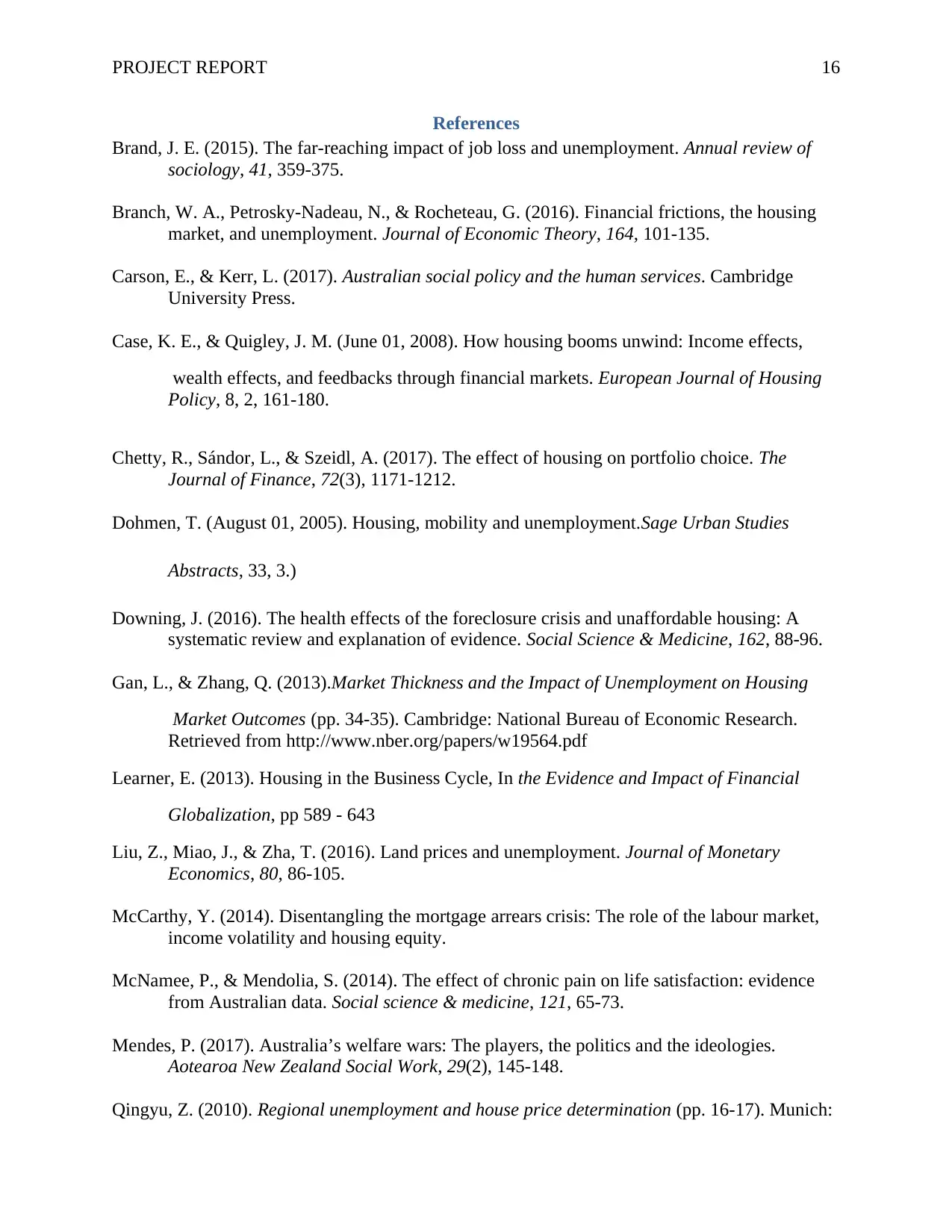
PROJECT REPORT 16
References
Brand, J. E. (2015). The far-reaching impact of job loss and unemployment. Annual review of
sociology, 41, 359-375.
Branch, W. A., Petrosky-Nadeau, N., & Rocheteau, G. (2016). Financial frictions, the housing
market, and unemployment. Journal of Economic Theory, 164, 101-135.
Carson, E., & Kerr, L. (2017). Australian social policy and the human services. Cambridge
University Press.
Case, K. E., & Quigley, J. M. (June 01, 2008). How housing booms unwind: Income effects,
wealth effects, and feedbacks through financial markets. European Journal of Housing
Policy, 8, 2, 161-180.
Chetty, R., Sándor, L., & Szeidl, A. (2017). The effect of housing on portfolio choice. The
Journal of Finance, 72(3), 1171-1212.
Dohmen, T. (August 01, 2005). Housing, mobility and unemployment.Sage Urban Studies
Abstracts, 33, 3.)
Downing, J. (2016). The health effects of the foreclosure crisis and unaffordable housing: A
systematic review and explanation of evidence. Social Science & Medicine, 162, 88-96.
Gan, L., & Zhang, Q. (2013).Market Thickness and the Impact of Unemployment on Housing
Market Outcomes (pp. 34-35). Cambridge: National Bureau of Economic Research.
Retrieved from http://www.nber.org/papers/w19564.pdf
Learner, E. (2013). Housing in the Business Cycle, In the Evidence and Impact of Financial
Globalization, pp 589 - 643
Liu, Z., Miao, J., & Zha, T. (2016). Land prices and unemployment. Journal of Monetary
Economics, 80, 86-105.
McCarthy, Y. (2014). Disentangling the mortgage arrears crisis: The role of the labour market,
income volatility and housing equity.
McNamee, P., & Mendolia, S. (2014). The effect of chronic pain on life satisfaction: evidence
from Australian data. Social science & medicine, 121, 65-73.
Mendes, P. (2017). Australia’s welfare wars: The players, the politics and the ideologies.
Aotearoa New Zealand Social Work, 29(2), 145-148.
Qingyu, Z. (2010). Regional unemployment and house price determination (pp. 16-17). Munich:
References
Brand, J. E. (2015). The far-reaching impact of job loss and unemployment. Annual review of
sociology, 41, 359-375.
Branch, W. A., Petrosky-Nadeau, N., & Rocheteau, G. (2016). Financial frictions, the housing
market, and unemployment. Journal of Economic Theory, 164, 101-135.
Carson, E., & Kerr, L. (2017). Australian social policy and the human services. Cambridge
University Press.
Case, K. E., & Quigley, J. M. (June 01, 2008). How housing booms unwind: Income effects,
wealth effects, and feedbacks through financial markets. European Journal of Housing
Policy, 8, 2, 161-180.
Chetty, R., Sándor, L., & Szeidl, A. (2017). The effect of housing on portfolio choice. The
Journal of Finance, 72(3), 1171-1212.
Dohmen, T. (August 01, 2005). Housing, mobility and unemployment.Sage Urban Studies
Abstracts, 33, 3.)
Downing, J. (2016). The health effects of the foreclosure crisis and unaffordable housing: A
systematic review and explanation of evidence. Social Science & Medicine, 162, 88-96.
Gan, L., & Zhang, Q. (2013).Market Thickness and the Impact of Unemployment on Housing
Market Outcomes (pp. 34-35). Cambridge: National Bureau of Economic Research.
Retrieved from http://www.nber.org/papers/w19564.pdf
Learner, E. (2013). Housing in the Business Cycle, In the Evidence and Impact of Financial
Globalization, pp 589 - 643
Liu, Z., Miao, J., & Zha, T. (2016). Land prices and unemployment. Journal of Monetary
Economics, 80, 86-105.
McCarthy, Y. (2014). Disentangling the mortgage arrears crisis: The role of the labour market,
income volatility and housing equity.
McNamee, P., & Mendolia, S. (2014). The effect of chronic pain on life satisfaction: evidence
from Australian data. Social science & medicine, 121, 65-73.
Mendes, P. (2017). Australia’s welfare wars: The players, the politics and the ideologies.
Aotearoa New Zealand Social Work, 29(2), 145-148.
Qingyu, Z. (2010). Regional unemployment and house price determination (pp. 16-17). Munich:
Secure Best Marks with AI Grader
Need help grading? Try our AI Grader for instant feedback on your assignments.
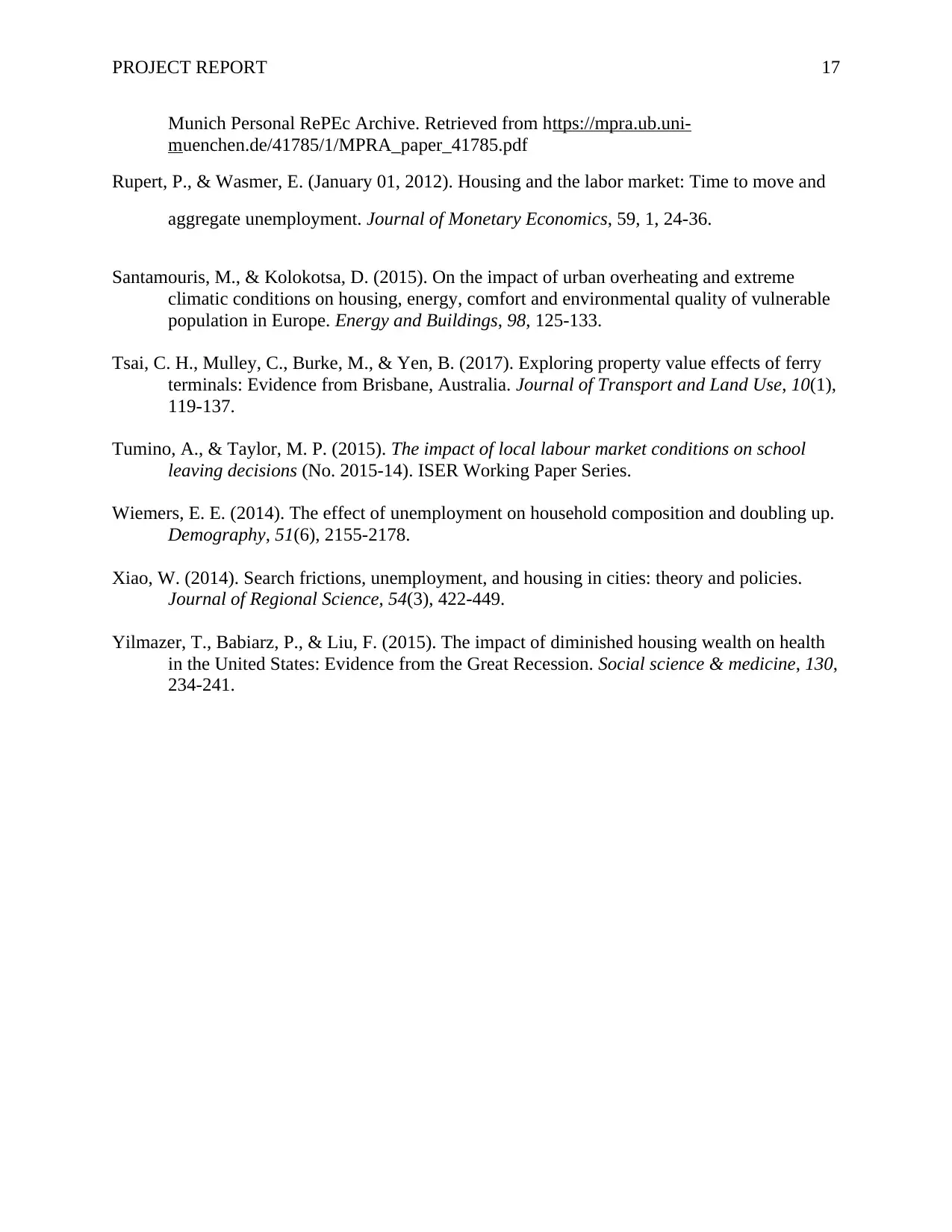
PROJECT REPORT 17
Munich Personal RePEc Archive. Retrieved from https://mpra.ub.uni-
muenchen.de/41785/1/MPRA_paper_41785.pdf
Rupert, P., & Wasmer, E. (January 01, 2012). Housing and the labor market: Time to move and
aggregate unemployment. Journal of Monetary Economics, 59, 1, 24-36.
Santamouris, M., & Kolokotsa, D. (2015). On the impact of urban overheating and extreme
climatic conditions on housing, energy, comfort and environmental quality of vulnerable
population in Europe. Energy and Buildings, 98, 125-133.
Tsai, C. H., Mulley, C., Burke, M., & Yen, B. (2017). Exploring property value effects of ferry
terminals: Evidence from Brisbane, Australia. Journal of Transport and Land Use, 10(1),
119-137.
Tumino, A., & Taylor, M. P. (2015). The impact of local labour market conditions on school
leaving decisions (No. 2015-14). ISER Working Paper Series.
Wiemers, E. E. (2014). The effect of unemployment on household composition and doubling up.
Demography, 51(6), 2155-2178.
Xiao, W. (2014). Search frictions, unemployment, and housing in cities: theory and policies.
Journal of Regional Science, 54(3), 422-449.
Yilmazer, T., Babiarz, P., & Liu, F. (2015). The impact of diminished housing wealth on health
in the United States: Evidence from the Great Recession. Social science & medicine, 130,
234-241.
Munich Personal RePEc Archive. Retrieved from https://mpra.ub.uni-
muenchen.de/41785/1/MPRA_paper_41785.pdf
Rupert, P., & Wasmer, E. (January 01, 2012). Housing and the labor market: Time to move and
aggregate unemployment. Journal of Monetary Economics, 59, 1, 24-36.
Santamouris, M., & Kolokotsa, D. (2015). On the impact of urban overheating and extreme
climatic conditions on housing, energy, comfort and environmental quality of vulnerable
population in Europe. Energy and Buildings, 98, 125-133.
Tsai, C. H., Mulley, C., Burke, M., & Yen, B. (2017). Exploring property value effects of ferry
terminals: Evidence from Brisbane, Australia. Journal of Transport and Land Use, 10(1),
119-137.
Tumino, A., & Taylor, M. P. (2015). The impact of local labour market conditions on school
leaving decisions (No. 2015-14). ISER Working Paper Series.
Wiemers, E. E. (2014). The effect of unemployment on household composition and doubling up.
Demography, 51(6), 2155-2178.
Xiao, W. (2014). Search frictions, unemployment, and housing in cities: theory and policies.
Journal of Regional Science, 54(3), 422-449.
Yilmazer, T., Babiarz, P., & Liu, F. (2015). The impact of diminished housing wealth on health
in the United States: Evidence from the Great Recession. Social science & medicine, 130,
234-241.
1 out of 17
Related Documents
Your All-in-One AI-Powered Toolkit for Academic Success.
+13062052269
info@desklib.com
Available 24*7 on WhatsApp / Email
![[object Object]](/_next/static/media/star-bottom.7253800d.svg)
Unlock your academic potential
© 2024 | Zucol Services PVT LTD | All rights reserved.





